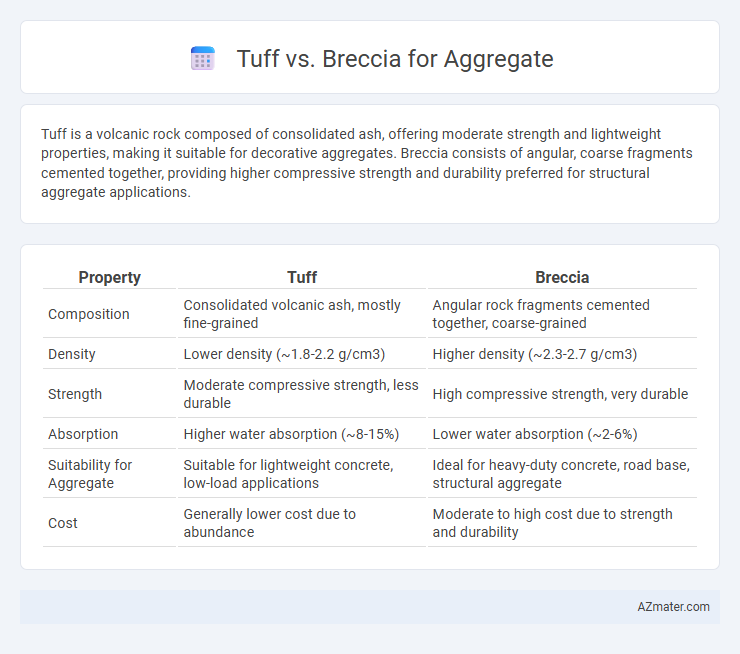Tuff is a volcanic rock composed of consolidated ash, offering moderate strength and lightweight properties, making it suitable for decorative aggregates. Breccia consists of angular, coarse fragments cemented together, providing higher compressive strength and durability preferred for structural aggregate applications.
Table of Comparison
| Property | Tuff | Breccia |
|---|---|---|
| Composition | Consolidated volcanic ash, mostly fine-grained | Angular rock fragments cemented together, coarse-grained |
| Density | Lower density (~1.8-2.2 g/cm3) | Higher density (~2.3-2.7 g/cm3) |
| Strength | Moderate compressive strength, less durable | High compressive strength, very durable |
| Absorption | Higher water absorption (~8-15%) | Lower water absorption (~2-6%) |
| Suitability for Aggregate | Suitable for lightweight concrete, low-load applications | Ideal for heavy-duty concrete, road base, structural aggregate |
| Cost | Generally lower cost due to abundance | Moderate to high cost due to strength and durability |
Introduction to Tuff and Breccia as Aggregates
Tuff and breccia are both volcanic rock types commonly used as aggregates in construction, with tuff being a softer, porous rock formed from volcanic ash, and breccia composed of angular, larger rock fragments cemented together. Tuff's lightweight nature and ease of cutting make it suitable for non-structural applications, while breccia offers higher strength and durability due to its coarse composition. The choice between tuff and breccia aggregates depends on factors like load-bearing requirements, abrasion resistance, and local availability.
Geological Formation and Characteristics
Tuff forms from volcanic ash ejected during explosive eruptions, resulting in a consolidated but relatively soft and porous rock with fine-grained particles. Breccia consists of angular, coarse fragments cemented together, typically formed by mechanical weathering or volcanic explosions, which provide higher strength and angularity for better interlock in aggregate applications. The geological formation of tuff involves rapid cooling of volcanic ash, whereas breccia's composition reflects sedimentary or volcanic brecciation processes, influencing their suitability as aggregates depending on strength and durability requirements.
Mineral Composition Comparison
Tuff and breccia differ significantly in mineral composition, affecting their suitability as aggregates. Tuff primarily consists of volcanic ash and small crystalline fragments, rich in minerals like feldspar, quartz, and volcanic glass, which contribute to its lightweight and porous nature. In contrast, breccia is composed of angular rock fragments cemented together, containing a more heterogeneous mix of minerals based on the source rock, often resulting in higher density and varied durability.
Physical Properties: Strength and Durability
Tuff exhibits lower compressive strength and reduced durability compared to breccia, making it less suitable for high-load aggregate applications. Breccia is composed of angular fragments cemented strongly, providing superior wear resistance and enhanced mechanical stability under stress. Its higher density and fracture toughness contribute to prolonged aggregate performance in construction and road-building projects.
Suitability for Construction Applications
Tuff and breccia vary significantly in their suitability for construction aggregates due to their differing compositions and durability. Tuff, a soft volcanic rock composed of compacted ash, is less durable and more porous, making it less ideal for heavy-load construction but suitable for lightweight and non-structural applications. Breccia, characterized by its angular, coarse fragments cemented together, offers higher strength and better load-bearing capacity, making it preferable for structural concrete, road base, and high-stress construction environments.
Processing and Workability Differences
Tuff exhibits lower hardness and porosity compared to breccia, making it easier to crush and produce uniform aggregate sizes during processing. Breccia's angular, coarse fragments require more intensive crushing and sorting, resulting in higher energy consumption and variability in workability. The workability of tuff-derived aggregate generally leads to better compaction and reduced voids in concrete, while breccia aggregates may demand modified mix designs due to their rough texture and heterogeneous composition.
Environmental Considerations
Tuff and breccia differ significantly in environmental impact when used as aggregate materials, with tuff typically exhibiting lower abrasion rates, reducing the need for frequent quarrying and decreasing habitat disruption. Breccia's angular fragments can enhance mechanical strength but often require more intensive extraction methods, leading to greater ecological disturbance and increased carbon emissions. Selecting locally sourced tuff can minimize transportation-related environmental footprints, supporting sustainable construction practices.
Cost and Availability in the Market
Tuff offers a cost-effective option for aggregate due to its widespread availability and ease of extraction, making it suitable for large-scale construction projects. Breccia, while generally more expensive, provides superior strength and durability but is less abundant, limiting its availability in many markets. Market pricing for breccia aggregates tends to be higher due to transportation costs and limited quarry sites compared to the more common and accessible tuff deposits.
Performance in Different Climates
Tuff aggregates exhibit high porosity and low density, resulting in reduced durability and increased freeze-thaw susceptibility in cold climates, making them less suitable for harsh weather conditions. Breccia, with its angular particles and higher density, offers enhanced strength and resistance to abrasion, performing reliably across a wide range of temperatures and climatic variations. For construction projects in climates with frequent temperature fluctuations or heavy precipitation, breccia provides superior long-term performance as an aggregate material.
Conclusion: Choosing Between Tuff and Breccia
Tuff offers lightweight aggregate benefits with good insulation properties, making it ideal for construction where reduced weight and thermal efficiency are priorities. Breccia provides higher strength and durability due to its angular fragments and cemented matrix, suitable for heavy-duty structural applications. Selecting between tuff and breccia depends on the specific project requirements, balancing weight, strength, and thermal characteristics for optimal aggregate performance.

Infographic: Tuff vs Breccia for Aggregate
 azmater.com
azmater.com